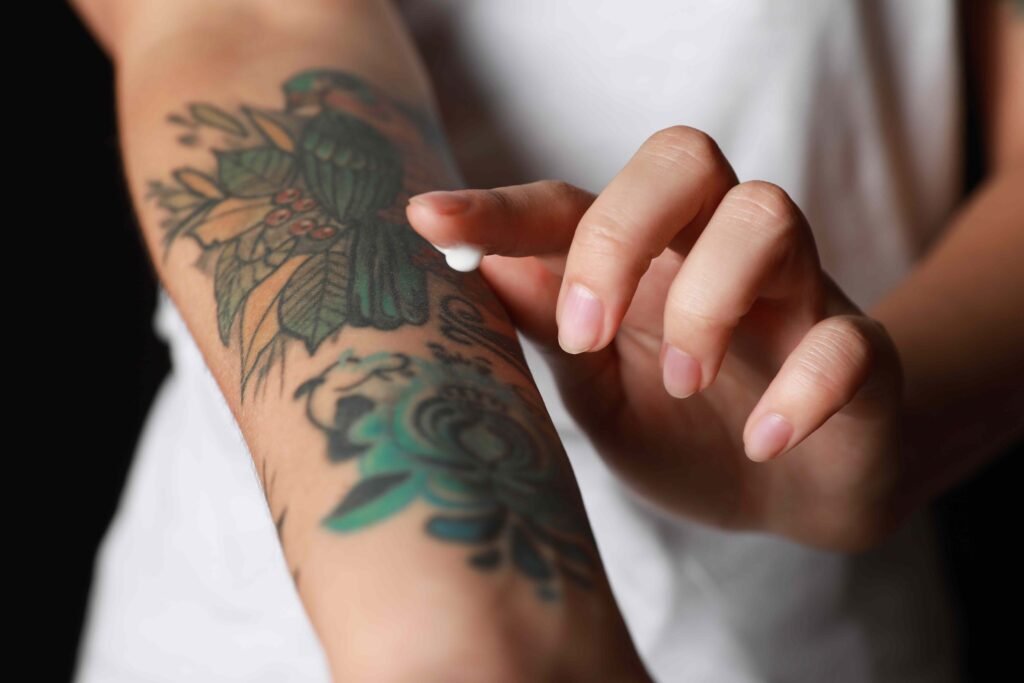Proper tattoo aftercare helps preserve your artwork and keep it looking its best long after you’re out from under the needle. It can also help ease common symptoms like swelling and itch while preventing more serious skin complications.
A fresh tattoo is an open wound. It may take up to three weeks for your skin to heal and recover. How you care for your tattoo in the first 24-48 hours can help set you up for the best results. Here’s what to keep in mind:
- Remove the dressing or bandage: Your tattoo artist may apply a dressing, bandage, or other covering after finishing the tattoo. You can remove the covering the same day when you’re ready to clean the tattoo.
- Clean the area gently: As you remove the dressing, you may notice leaking fluid, which is expected. Use gentle, fragrance-free soap and warm water to clean the tattoo twice per day. Be gentle and pat (don’t rub) dry with a clean towel.
- Stay out of water: You can clean and dry your tattoo, but avoid soaking. With healing, the tattoo can weep ink. If you need to shower, apply a waterproof covering to the tattooed area.
- Apply ointment or lotion: Two to three times per day, apply an ointment or moisturizing lotion that’s water-based or formulated with glycerin. Avoid petroleum jelly, which may encourage fading.
- Avoid sun exposure: Protect your tattoo from direct sunlight by wearing long sleeves, scarves, hats, or other coverings. Until the tattoo heals, avoid using sunscreen to avoid irritation on broken skin.
- Don’t scratch: A healing tattoo may be itchy, but resist the urge to scratch. Scratching damages the tattoo and causes scars. Avoid touching or disturbing the tattoo.
- Don’t pick: Don’t pick at any raised areas or scabs. Let extra skin flake off and heal naturally.
Normal healing may involve certain symptoms for a few weeks after getting your tattoo. These include:
- Soreness or tenderness
- Swelling
- Skin sensitivity
- Itching
- Oozing clear fluid
- Redness
- Slight scabbing or raised areas
Following proper tattoo aftercare steps can help you manage these symptoms.
Because a tattoo is a wound, there’s a chance of complications.
Infection
The symptoms of a tattoo infection may come on between a few hours to months after getting the tattoo. Signs of infection include:
- Redness or discoloration gets darker
- Chronic or worsening pain
- Rash or itchy, red bumps on the tattoo
- Fever or chills
- Leaking thick fluid
- Open sores
What to do: Infections can get worse without treatment, so get medical help if you have any signs.
Allergic Reaction
Some people may experience an allergic reaction to any color of ink, though red is most likely. An allergic reaction may occur days to months after the session, with symptoms that include:
- Persistent redness and swelling
- Itch that doesn’t go away
- Pimple-like bumps
- Lumps in deeper skin
- Blisters
- Crusty, flaky skin
- Fluid leaking from the area
What to do: If these symptoms don’t go away within two weeks, call your primary care doctor or a dermatologist (skin specialist). Call 911 or seek emergency care if you experience signs of anaphylactic shock, a potentially fatal reaction that may cause hives, a swollen face or throat, and breathing difficulty.
Sun Allergy
Tattooed skin may develop a sun allergy. Appearing minutes to hours after sun exposure, symptoms may include:
- Swelling and redness around the tattoo
- Itchy rash of small bumps
- Blisters
- Hives
What to do: Seek care from your primary care physician or a dermatologist if you have severe symptoms.
Chronic Skin Diseases
If you have psoriasis, eczema, or another chronic skin disease, getting a tattoo can sometimes trigger symptoms. Within weeks of getting the tattoo, you may experience:
- Flaky, dry, itchy skin
- Raised, irregularly shaped areas of scaly skin
- Fluid weeping from the skin
- Fragile skin or easily bleeding
What to do: Eczema and psoriasis go through flare-ups and quiet periods. If the symptoms interfere with daily life, seek care from a dermatologist.
Long-term tattoo care can help prevent fading after the tattoo has healed. Try these tips:
- Use sunscreen: Direct sunlight causes tattoos to fade. After the tattoo has healed, apply sunscreen about 30 minutes before going out into the sun. Use sun protection factor (SPF) 30 or higher and reapply every two hours.
- Prevent sun exposure: Cover up the tattoo if you’re going out into the sun.
- Avoid tanning beds: Ultraviolet (UV) rays may lighten tattoos.
- Clean and moisturize: Don’t let the tattooed skin get too dry. Keeping a routine of cleaning and moisturizing helps, even after the tattoo has healed.
- Check on your skin: If you see any new moles or growths on your body, let your healthcare provider or a dermatologist know.
- Drink water: Good hydration helps preserve moisture in your skin, preserving your tattoo’s appearance.
As your new tattoo heals, it’s important to clean and moisturize the area and to avoid scratching or picking, even as scabbing and flaking may occur. Symptoms like swelling, redness, and itchiness are common, and they should improve as your tattoo heals. If they last longer than a week, consider reaching out for medical care.

